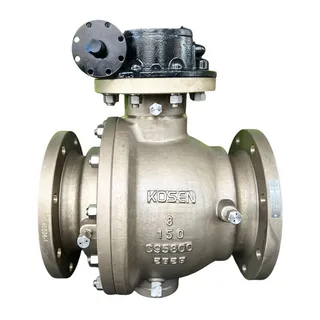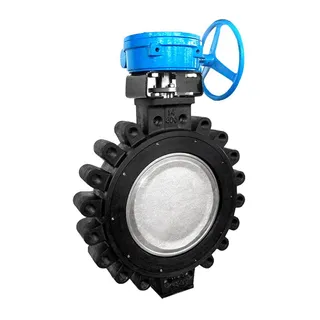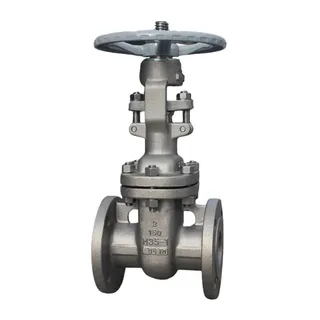In industrial production, valves are critical components of fluid control systems, and their importance is self-evident. As a special type of ball valve, V-Port Ball Valves stand out among various valve types due to their unique design and excellent performance, becoming an important choice in industrial process automation systems. This article will explore in depth the features, structure, advantages, and wide applications of V-Port Ball Valves, helping readers gain a comprehensive understanding of this efficient regulator.
V-Port Ball Valves are a special form of ball valve. Their closure element is a hemispherical ball with a V-shaped opening. This design gives V-Port Ball Valves their unique performance. The V-shaped opening has a sharp edge, and during the rotation of the ball, a wiping action occurs between the closure elements, providing strong cutting force on the medium. At the same time, the V-shaped opening of the ball and the valve seat flow passage form a fan-shaped area. During rotation, the flow passage area can be changed, achieving precise regulation of the medium. V-Port Ball Valves are quarter-turn control valves, with sealing performance equivalent to ordinary ball valves, combining both regulation and on-off functions. When paired with pneumatic or electric actuators, V-Port Ball Valves are widely used in industrial process automation systems.
V-Port Ball Valves mainly consist of the valve body, ball, valve seat, stem, and actuator. The interior of the valve body forms a passage that matches the V-shaped cut of the ball, allowing fluid to flow. Depending on the medium and operating conditions, the valve seat can be metal hard-sealed or PTFE soft-sealed. The stem connects the ball to the actuator, and the rotation of the actuator drives the ball to rotate, realizing valve opening, closing, and flow regulation.
When the valve is closed, the ball rotates to a position where the V-shaped cut fits tightly with the valve seat, blocking fluid flow. When flow adjustment is needed, the ball is rotated to change the opening of the V-shaped cut, thereby changing the flow passage area and achieving accurate flow control. The V-shaped cut design allows precise adjustment of small flows even at low openings, providing a large turndown ratio. During medium flow, the V-shaped cut generates shear force, which can remove impurities and particles in the medium, keeping the valve unobstructed.
After understanding the basic structure and working principle of V-Port Ball Valves, we will now explore their unique advantages. These advantages make V-Port Ball Valves stand out among many valve types, becoming a preferred choice in industrial control systems. Let's take a closer look at the main features of V-Port Ball Valves.
The flow regulation performance of V-Port Ball Valves is the best among ball valves. Its flow characteristic is nearly equal percentage, with a turndown ratio up to 100:1. This means that even at low openings, V-Port Ball Valves can achieve precise adjustment of small flows. In comparison, traditional straight-through single-seat control valves, double-seat control valves, and sleeve control valves only have a turndown ratio of 30:1, giving V-Port Ball Valves a significant advantage in this regard.
The V-shaped opening of the V-Port Ball Valve has a sharp edge. During the rotation of the ball, a wiping action occurs between the closure elements, providing strong cutting force on the medium. This design allows V-Port Ball Valves to fit tightly against the valve seat when closed, achieving zero leakage. Whether dealing with fiber-containing, fine solid particles, slurry, or high-viscosity, corrosive media, V-Port Ball Valves can effectively cut off the fluid.
The shear effect between the V-shaped cut of the V-Port Ball Valve and the valve seat removes impurities during medium flow, keeping the valve unobstructed. This self-cleaning function prevents medium accumulation during long-term operation and reduces the risk of blockage, making it particularly suitable for systems with fiber and solid particle media.
The sealing performance of V-Port Ball Valves is equivalent to ordinary ball valves. The sealing surfaces between the ball and the valve seat use special materials and structural designs to ensure good sealing when closed, reducing fluid leakage. Depending on the medium and operating conditions, the valve seat can be metal hard-sealed or PTFE soft-sealed. Metal hard-sealed seats are treated by overlay welding of hard alloys, spherical chrome plating, welding, or ion nitriding to enhance seal lifespan and increase temperature resistance. Soft PTFE or reinforced PTFE seats provide good sealing, corrosion resistance, and a wide range of applicability.
Wafer-type and flanged V-Port Ball Valve bodies both feature a one-piece side-mounted structure with high rigidity, reducing the risk of deformation and external leakage. Self-lubricating upper and lower bearings inside the valve body have large contact areas with the stem, high load capacity, and low friction, reducing valve torque. The lightweight valve body and low stem torque allow smaller actuator sizes. Compared with other types of control valves, V-Port Ball Valves offer high cost-performance ratios.
Next, we compare V-Port Ball Valves with other common ball valve types. Through comparison, the unique advantages of V-Port Ball Valves and their suitability for different applications become clearer, helping users select the most appropriate ball valve type according to specific operating conditions.
O-type ball valves have a solid spherical ball core with a circular flow passage. This design allows straight-through flow when fully open, reducing pressure loss. O-type ball valves are simple and quick to operate, requiring only a 90° rotation of the ball core. Their inlet and outlet typically have two seat seals to ensure reliability. However, O-type ball valves have relatively poor regulation performance and are mainly used for on-off control. When handling media with many impurities or solid particles, O-type ball valves are prone to cavity blockage, causing the valve to seize or fail. In contrast, V-Port Ball Valves have superior regulation performance, a large turndown ratio, and self-cleaning, preventing medium accumulation and sedimentation, ensuring long-term reliable operation.
Ceramic and PTFE-lined ball valves also have V-shaped cores. Ceramic ball valves are wear-resistant and acid/base resistant, suitable for particle-containing media regulation. PTFE-lined ball valves are used for acid/base corrosive media regulation. V-Port Ball Valves are also widely used in these areas. Their metal hard-sealed structure and self-cleaning function allow excellent performance with fiber-containing, fine solid particles, slurry, high-viscosity, and corrosive media. Compared with ceramic and PTFE-lined ball valves, V-Port Ball Valves have a wider range of applications and higher cost-performance.
V-Port Ball Valves play an indispensable role in many industrial fields due to their unique design and excellent performance. Applications range from traditional manufacturing to high-tech industries, and from simple fluid control to complex automated systems.
The shear effect between the V-cut and valve seat makes V-Port Ball Valves particularly suitable for fiber-containing, fine solid, and slurry media. In industries such as paper, chemical, and pharmaceuticals, controlling such media has always been challenging. V-Port Ball Valves can effectively cut fibers and particles, prevent blockage, and ensure stable system operation.
The metal hard-sealed structure of V-Port Ball Valves makes them suitable for harsh conditions such as high temperature, high pressure, and corrosive media. In petroleum, chemical, and pharmaceutical industries, controlling high-viscosity and corrosive media requires valves with excellent corrosion resistance and sealing performance. V-Port Ball Valves with hardened metal seats can withstand high temperature and pressure while maintaining good sealing, making them ideal for these harsh conditions.
When paired with pneumatic or electric actuators, V-Port Ball Valves are widely used in industrial process automation systems. Their superior regulation performance allows precise flow control, meeting the high accuracy requirements of fluid control in industrial production. Whether in automated production lines, chemical reactors, or pharmaceutical equipment, V-Port Ball Valves provide reliable control solutions.
V-Port Ball Valves play a vital role in industrial process automation systems due to their excellent flow regulation, strong shut-off capability, self-cleaning function, and high sealing performance. They are suitable for fiber-containing, fine solid, slurry, high-viscosity, and corrosive media, and are widely used in paper, chemical, pharmaceutical, petroleum, and other industries. Compared with O-ball, ceramic, and PTFE-lined valves, V-Port Ball Valves have significant advantages in regulation performance and application range. When selecting and using V-Port Ball Valves, users should choose the valve seat type, actuator, and specifications according to specific operating conditions and conduct regular maintenance to ensure long-term stable operation. Through scientific and reasonable selection and use, V-Port Ball Valves will bring more convenience and benefits to industrial production.



